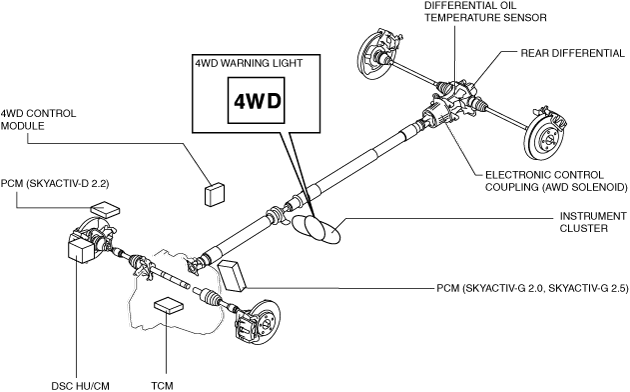4-WHEEL DRIVE SYSTEM
id031800170000
Outline
• The electronic 4-wheel drive (4WD) control system automatically and optimally controls drive torque distribution for the front and rear wheels. Due to this off-road mobility and driving stability are improved.
• Based on the input signals from each sensor, the 4WD control module (CM) determines vehicle driving and road conditions, and controls output current to the electronic control coupling (4WD solenoid) inside the rear differential. This control allows for optimal distribution of the drive torque from the engine to the rear wheels.
• Also, the 4WD CM automatically controls the 4WD, greatly reducing the load on the driver and improving operability.
Structural View
Structure
• Consists of the following parts:
|
Electronic control coupling (4WD solenoid)
|
|
|
4WD CM
|
|
|
Differential oil temperature sensor
|
|
|
4WD warning light
|
|
System Diagram
Features
• Based on the inputted signals listed below, the 4WD CM calculates the optimal amount of torque distribution for the rear wheels and outputs a corresponding electric control current to the electronic control coupling (4WD solenoid).
• The module controls the current outputted to the 4WD solenoid by changing the rate of the ON/OFF timing.
|
Signal output part
|
Signal name
|
Note
|
|
PCM
|
Engine speed
Engine torque
Accelerator pedal position
Clutch pedal position
Transaxle gear position (MTX)
Neutral switch status
Cruise control status
Engine off time
Ambient temperature
Car configuration data
|
Transmitted as a CAN signal
|
|
TCM
|
Selector lever position
Transaxle gear position (ATX)
|
|
DSC HU/CM
|
Four-wheel speed
Brake fluid pressure
Coupling torque request
|
|
EPS control module
|
Steering angle/steering angle sensor condition
EPS status
|
|
Start stop unit
|
Windshield wiper switch status
|
|
Instrument cluster
|
Parking brake position
Car configuration data
|
|
Differential oil temperature sensor
|
Rear differential oil temperature
|
—
|
Block Diagram
Operation
Normal Control
-
• When starting off or accelerating during straight-ahead driving, torque transmitted to the rear wheels is optimally controlled to ensure sufficient acceleration performance. Due to this, standing-start and acceleration performance is improved.
• If a parking brake signal input to the 4WD CM indicates, the module controls the torque transmitted to the rear wheels.
Tight Cornering Control
-
• When the 4WD CM determines that the vehicle is in tight cornering, it reduces the torque transmitted to the rear wheels to avoid tight corner braking characteristics.
Integrated DSC Control
-
• If a signal from the DSC HU/CM input to the 4WD CM indicates that ABS control is activated, the module controls the torque transmitted to the rear wheels to prevent undue influence on ABS control.
• Also, when a coupling torque request signal is received from the DSC HU/CM, the module controls the torque transmitted to the rear wheels to match the amount of requested torque.
Other Control
-
• In case the rear differential oil temperature exceeds the specified amount, or when there is an unusually large variation in the rotation speed of the front and rear wheels (ex. when trying to get unstuck), control is temporarily suspended in order to protect the 4WD system. When this occurs the 4WD warning light flashes to indicate the situation to the driver.
